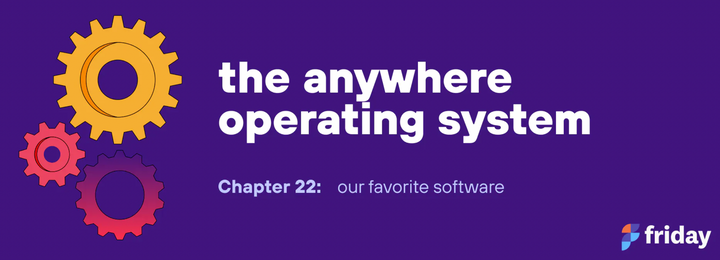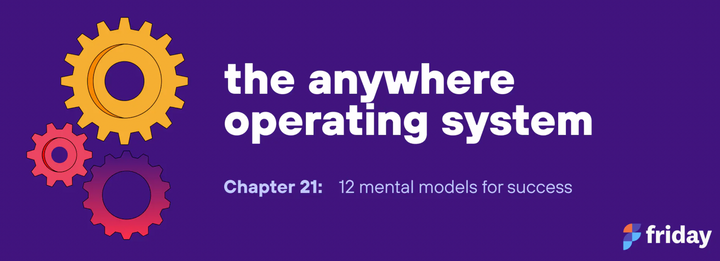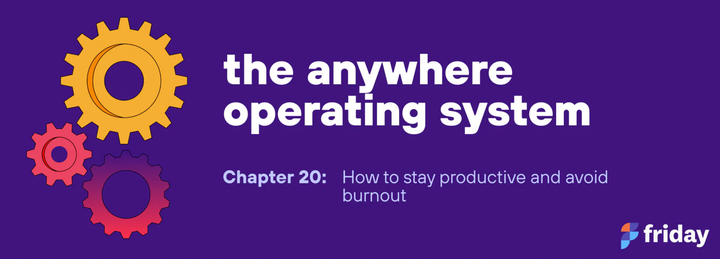Chapter 3: The office vs. remote work

At this point, I hope we’ve convinced you that there’s a major shift underway in our world. This shift has the potential to change the way we live and work.
Now, I’d like to discuss the pain that you may feel as you adapt to this new way of working. I call this idea, “the gap.” While I am a remote work advocate, it’s also important to be realistic and intellectually honest instead of spouting hype. There is no perfect solution. Remote is not perfect. The office is not perfect.
If we want to navigate this change, we need to understand the benefits of remote and the strengths of the office. Then, we need to build a way to bridge the gap between the office and a work-from-anywhere model.
A day at the office
Imagine a day at the office. You walk in the front door a few minutes before 9 a.m., which creates a visual reminder that it’s time to enter work mode.
You arrive at your desk, collect your thoughts, and power up your computer. You go to the kitchen and make coffee. In the kitchen, you run into a coworker from another team. You say hi and ask how their weekend went – small talk ensues. Over the course of the discussion, you discover that another department is working on a cool project that you didn’t know about before.
You return to your desk, put on headphones, and start replying to emails. You scramble to do work before chaos hits. After the team shows up, you have a daily standup meeting where everyone shares what they did yesterday, what they are working on today, and any blockers they face. It’s not the best use of your time, but this ritual makes you feel a bit more connected and aware of what people are working on. You go back to your desk and resume working. Your coworkers are chatting next to you, but you have noise cancelling headphones on so it doesn’t bother you too much.
After a bit of work, you look up and see coworkers through the glass conference room doors in a meeting. Things look tense. Is that the finance team? Interesting. You wonder if you should ping them. Perhaps it’s related to end-of-quarter results?
Lunch time arrives and you grab a bite to eat with a colleague. You chat about work, but you also shoot the breeze and find out if they have any interesting plans for the weekend.
After lunch, you try to do more heads-down work, battling emails, Slack notifications, and other pings. You go to a couple meetings and try to free up time to get things done.
A couple hours later, you wrap up your day feeling a little behind the ball, but it’s time to go home. You bring your laptop. Hopefully you won’t have to do too much work later after the kids go to sleep. You get stuck in traffic on the way home, so you end up arriving late and can’t spend as much time with the kiddos.
Rinse and repeat. Friday can’t come soon enough.
Then COVID-19 hits.
A day working from home
Now, you’re forced to work from home. Thanks, COVID-19.
Instead of walking into the office, you try to find space in your home to get things done. You create a makeshift desk at the kitchen table. Work and life happens in one place now. You power up your computer while you make coffee in the kitchen.
Within a few minutes, chaos arrives. Emails start coming in. Coworkers start pinging you on Slack at the worst possible times. Meanwhile, your kiddo has to stay home and he’s not excited about spending the entire day with you.
As a leader, you decide to run your daily standups over Zoom at 9 a.m., but they feel a bit different when remote. People are tripping over each other on the call. You look at one of your coworkers and they are living the dream. They have their own home office, no frustrated children, and a big smirk on their face.
The workday continues. The pings won’t stop. The meeting invites drive you nuts.
Is Bob even working? It looks like he’s never online when you check Slack. Meanwhile, your coworkers are breathing down your neck. They want to schedule an update meeting. It’s impossible to know if your team is working on the most important things right now. It’s a freaking pandemic after all. At the office, you could walk over to where your team was congregated and ask them what they were working on. It used to be so easy. Not anymore!
You sit at the kitchen table, frustrated about the situation. You feel disconnected and out of the loop. The online communication makes you feel like your team is a bunch of emotionless robots and not the friendly people you remember from the office gatherings.
You decide to schedule a virtual happy hour with your team so you can shoot the breeze and catch up. It ends up being awkward and everyone seems tired and excited for the call to end. You miss the in-person water-cooler chats; your team is becoming demotivated and tensions are high. Miscommunication is rampant.
Despite the struggle, you see potential. If you could figure this out with your team, you could cut out the two-hour commute and get some of your life back. When the pandemic ends, the kiddo could go back to school and you could focus again. Maybe you can build out one of the bedrooms and turn it into an office. Maybe you could work from your favorite coffee shop a couple mornings a week.
You are intrigued by this way of working, but everything is so stressful right now.
How our environment shapes how we work and communicate
If you compare the office and home, the average day looks and feels quite a bit different.
When you walk into the office, you are constantly gathering data through observation and osmosis. This environment activates your senses (sight, sound, maybe even smell) to understand what’s going on. Working from the office is like watching a movie in high definition. When you chat with coworkers, you can read their body language, tone of voice, and more. It’s easy to pull your team into a room for a quick meeting or white-boarding session.
If you think about the design of the office (especially an open office floor plan), these spaces are intentionally built to encourage random collisions and interactions with coworkers.
While this environment is ideal for collaboration and quick conversations, it’s a terrible place to do heads-down, focused work. If you want to do your best thinking, you need to put on noise-cancelling headphones.
On the other hand, when you work outside the office, it’s easy to feel disconnected. You have less data that you can observe. You need to rely on your email inbox, Slack, or endless Zoom calls to understand what people are working on. If working from the office is like watching a movie in HD, working from home is like watching an old movie in black and white.
With that being said, working from home has the potential (at least when it’s not a pandemic) to give you a newfound sense of freedom over your day. In theory, you can work where and when you are most productive. You can focus and do more deep work compared to the noisy office. You can take a break and go for a walk if you need to clear your mind. And there’s no commute. You have more control over your time and it feels good.
The gap
When you work remotely, it’s easy to feel like you are missing out…because you are! This is the gap. It’s the difference between what you used to experience at the office and how you are feeling right now. You miss the context and awareness that you had at the office.
It’s normal to use the existing tools in your toolbox to try to bridge this gap too. You try to replicate the office environment online with a virtual office tool. You want to feel more connected with coworkers, so you schedule a Zoom happy hour. Many of these efforts fail. What do you do?
Building a bridge to cross the gap
The good news is that there’s a way to build a bridge to cross this gap, but it will require a different approach than that which you are accustomed to. You can’t rely on more Zoom calls or another ping in Slack. The tools that worked well at the office don’t work as well in this new world. You need a different set of tools, methods, and processes to build the bridge to cross the gap.
Want to keep reading? In the next chapter we will share the open secret to working from anywhere.


